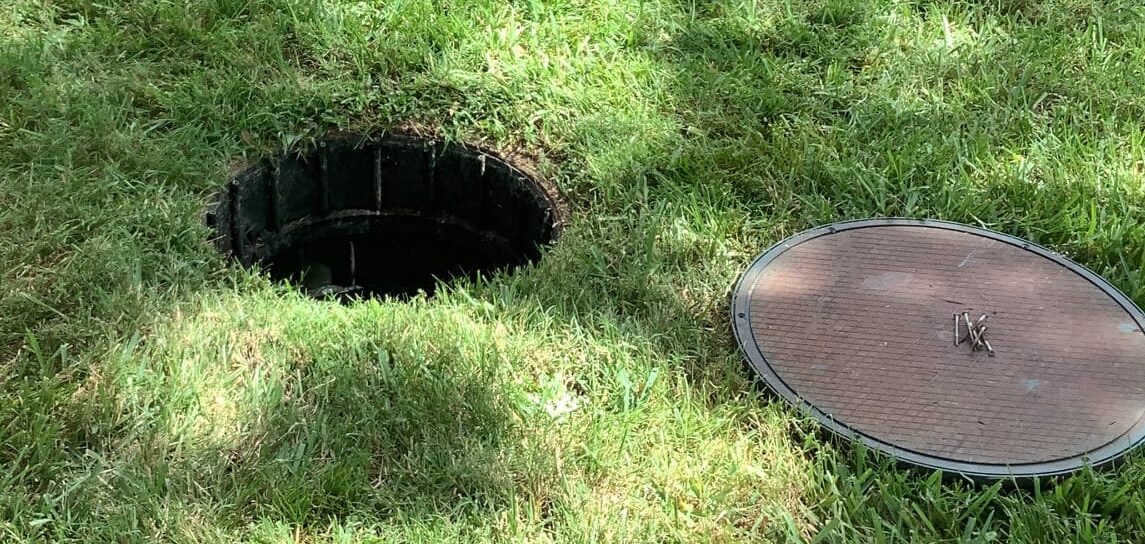The lid on your septic tank is essential to your septic system’s functionality. In this guide, we’ll cover the why of septic tank lids, the different types of lids, how to locate them, replace them when necessary, and essential tips for lid maintenance.
Five Reasons Why We Use Septic Tank Lids
Like the rest of your septic system, your septic tank lid plays an important role.
- Safety: Lids prevent accidental falls or entry into the tank, which can be dangerous or fatal. They protect both humans and animals by securing the opening.
- Health: By sealing the tank, lids help contain harmful gases and bacteria produced during the wastewater treatment process, preventing them from escaping into the environment.
- Accessibility: Lids provide access points for maintenance, inspection, and pumping services. Properly designed lids make these necessary tasks more accessible and efficient.
- Prevent Debris Entry: Lids keep out rainwater, debris, and other materials that could disrupt the tank’s functioning or cause blockages.
- Regulatory Compliance: Many local regulations and health codes require septic tanks to have secure lids to ensure public health and environmental protection.
Why Does My Tank Have Two Lids?
Some septic systems have two lids: an inlet access and an outlet access. The lid closest to the house is considered the inlet access, and the lid farthest from the house is the outlet access. The inlet lid is removed during inspections to check fluid levels and check for clogs in the inlet pipe, and the outlet access is where the filter is located. Homeowners may need to find and remove their septic lid during regular maintenance. Some reasons you would need to remove the septic lid are to clean your filter, check fluid levels, and check for inlet pipe clogs.
Types of Septic Tank Lids
Septic tank lids come in various materials and designs that match their septic tank. Like septic tanks, common materials include concrete, plastic (polyethylene), and fiberglass. Each type offers unique advantages:
- Concrete Lids: Known for their durability, a concrete lid can withstand more weight than other material types and provide reliable protection.
- Plastic Lids: High-density polyethylene (HDPE) lids are lightweight, corrosion-resistant, and easier to handle during installation and maintenance.
- Fiberglass Lids: Fiberglass offers a middle ground, combining strength and lighter weight, making them a practical choice for many homeowners.
Finding My Septic Tank Cover
Finding your septic tank can be challenging, but a few pointers can help. You can start by examining your property’s as-built or septic system design, which may include the lid’s location. If this isn’t available, these steps may help:
- Follow the Plumbing: Begin with the path of your home’s plumbing system by finding your plumbing cleanout. The septic tank lid is typically in a straight line from the cleanout.
- Check the Yard: Look for any irregularities in your yard, like depressions or utility hole covers. Often, the lid is slightly below ground level and might have grass or vegetation growing around it.
- Consult Professionals: If your septic tank lid remains elusive, professional septic services like ACE Septic & Waste have the tools and expertise to locate it accurately and quickly.
Replacing a Septic Tank Lid
Over time, septic tank lids can deteriorate or become damaged. When this happens, replacing the lid is important to prevent the internal fluids within the tank from contaminating the ground and groundwater. Here’s a general outline of the replacement process:
- Locate the Lid: First, find the existing lid. Ensure it’s accessible and safe to work on.
- Measure and Note: Take precise measurements of the existing lid’s dimensions, ensuring the replacement is an exact fit.
- Remove the Old Lid: Gently remove the old lid. If the tank has risers, be careful not to damage them during removal.
- Install the New Lid: Install the new lid, ensuring it is positioned to line up with any existing riser or adapter.
- Secure It: Secure it by using appropriate fasteners or screws to secure the lid in place.
Remember that lid replacement is best for professionals to guarantee the correct material, fit, alignment, and seal. The last thing you want to do is make a mistake replacing the lid, which could lead to expensive repairs for a failed or damaged system.
Protecting Your Lid
The septic tank lid is crucial in maintaining your system’s efficiency and longevity. To ensure it serves its purpose effectively:
- Regularly inspect the lid for cracks, damage, or signs of deterioration.
- Keep the area around the lid clear to provide easy access during maintenance.
- Avoid placing heavy objects or driving over the lid.
- Never park your vehicle on the lid, and never drive over it.
- Install safety barriers if necessary to prevent accidental damage or injuries.
Understanding the significance of your septic tank lid and practicing essential maintenance can prolong your system’s life and keep it functioning smoothly. If you need septic system repairs or maintenance, call ACE Septic & Waste for the best septic care Tampa Bay and Central Florida can offer.







